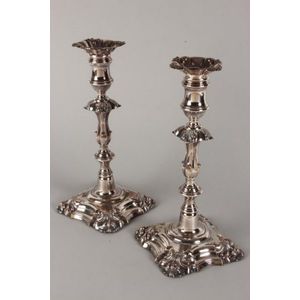Georgian Sheffield Plate Candlesticks with Acanthus Scrolls (Pair)
You must be a subscriber, and be logged in to view price and dealer details.
Subscribe Now to view actual auction price for this item
When you subscribe, you have the option of setting the currency in which to display prices to $Au, $US, $NZ or Stg.
- Georgian - As an English stylistic period, Georgian is usually taken to cover the period from George I (1714) to the Regency of Prince George (1811-20), although the period from 1800 to 1830 is sometimes designated as the Regency period. During the Georgian period the great English cabinetmakers and designers such as Chippendale, Hepplewhite, Adam Sheraton etc., were all active.
Therefore there isn't a single 'Georgian style' as such and to say something is 'Georgian', usually means it was made between 1714 and 1830. This assumes we discount George V and George VI, both being from the 20th century.
The styles popular at the time of each reign were:
George I (1714-1727) saw out the last years of the Baroque period.
George II (1727-1760) reigned during the Rococo period.
George III (1760-1820) saw the last gasp of the Rococo, all of the early Neo-Classic 'Adam style' and most of the later neo-Classic 'Regency style'.
George IV (Prince Regent 1820-1830)encompassed the last of the 'Regency' style.
William IV's reign (1830-1837) was something of a no man's land (stylistically) and he wasn't a 'George' anyway. He covered the last glimmerings of 'Regency' and the start of the 'Victorian' style. - Sconce - A light attached to a wall. Originally a candle holder that is attached to a wall with an ornamental bracket and sometimes with a reflective back plate, but now applied to an electric light that has been inspired by that design.
In recent times the word has also come into use to desribe the candle holders on a candelabra. - Acanthus - A stylized leaf motif, one of the primary decorative elements of classical Greek and Roman architecture, derived from the genus of flowering plants in the family Acanthaceae, native to tropical and subtropical regions of the Mediterranean area. It is a common element in classical Greek and Roman design, and is often seen in Corinthian and Composite order columns and used as a decorative element in English, European and Australian furniture, particularly on the curve of a leg, and as decoration for a corbel.
This item has been included into following indexes:
Visually similar items

Pair of mid 19th century Elkington candlesticks, c.1841, handsomely decorated with acanthus motifs on a shaped support and serpentine base, impressed factory marks, height 31 cm, (2)

A pair of George II style silver plated candlesticks, 1860s, on shaped square bases, fluted stems with decorative squared knops, removable shaped drip pans and with gryphon engraved Crests. Height 24.5 cm. Width 11 cm. Depth 11 cm

Pair of Victorian silver plate candlesticks, marked George Richmond Collis, 1840-1893, Birmingham, in rococo taste, of tapering baluster form, decorated with acanthus and c-scrolls, height 32 cm (2)

Pair of Jewish silver candlesticks possibly sabbath candlesticks, with detailed acanthus leaf decoration on a a graduated mid section, provenance probably from the Baltic region, height 24 cm, weight 491grams
